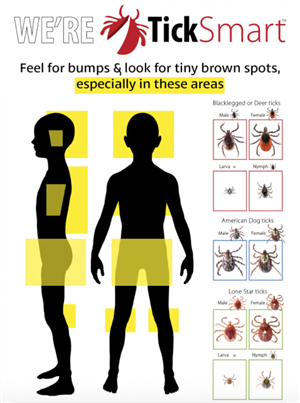Health Services
Page Navigation
- Home
- AED/CPR Information
- Building Nursing Staff
- CHIP Insurance
- Elementary Growth & Development
- Health Services Forms
- Immunizations
- Medication Policy
- Nurse Substitute Information
- Pediculosis (Head Lice)
- Stop the Bleed
- Sunscreen Information
- Ticks
- Too Sick for School?
- Voluntary Student Accident Insurance
-
TICKS
For the past several years, Pennsylvania has been the top ranked state for the most reported cases in the U.S. for Lyme Disease. Lyme Disease is a bacterial infection transmitted to humans through the bites of infected deer ticks, especially by the nymphal deer tick. The nymphal deer tick is so small that many people are not aware when they’ve been bitten by a tick and may not make a connection when they begin to experience symptoms. Symptoms can include fever, headache, general achiness, swollen glands, fatigue, and a possible bullseye rash and symptoms may not appear for weeks, months, or even years after a tick bite. In young people, Lyme Disease may initially present as a typical acute illness and then resolve. Behavioral changes, changes in academic performance, and mental health concerns may then present after an acute illness that alerts parents that something else is going on (PA Lyme Resource Network, 2018).
Prevention is key to avoiding a tick bite! Here are a few tips you can follow.
- Wear protective clothing: Wear long sleeves and pants, tuck your pants into your socks, and wear light-colored clothing so that ticks are easier to spot.
- Use insect repellent: Apply insect repellent containing DEET to your skin and clothing to repel ticks.
- Check for ticks regularly: After spending time in tick-infected areas, check your body for ticks and remove any that you find promptly.
- Avoid tick infested areas: Ticks thrive in tall grass, woods, and brush, so avoid walking in these areas when possible.
- Keep your yard tick free: Keep your lawn mowed and trim tall grass and brush. Consider using tick control products to reduce the number of ticks in your yard.
- It's also important to be aware of the symptoms of Lyme disease and seek medical attention if you experience any symptoms, such as a bull's-eye rash, fever, headache, or muscle and joint aches. Early treatment with antibiotics is effective in most cases.
PLACES TO CHECK FOR TICKS:
- In/behind ears
- Scalp and hair
- Armpits
- Belly button
- Groin area
- Behind the knees
- In-between toes
- Under any skin folds
(TickEncounter Resource Center, 2018)

SYMPTOMS CAN INCLUDE:
- Bull's Eye Rash—Keep in mind that 50% of individuals with Lyme Disease never see a bull's eye rash. The bull's eye rash is a definite indicator that the individual has Lyme Disease.
- Fever
- Headache
- Flu-like symptoms (chills, sweats, nausea, and muscle aches)
- Bell's palsy (facial paralysis)
- Extreme/persistent fatigue
- Swollen glands
- Exercise intolerance
- Insomnia
- Memory issues and brain fog
HOW TO REMOVE A TICK
- Use fine-tipped tweezers to grasp the tick as close to the skin’s surface as possible. Apply gloves prior to removing the tick to protect any open cuts on your skin.
- Pull upward with steady, even pressure. Don’t twist or jerk the tick as this can cause the mouth-parts to break off and remain in the skin. If this happens, remove the mouth-parts with tweezers.
- After removing the tick, thoroughly clean the bite area and your hands with rubbing alcohol, or soap and water.
- Never crush a tick with your fingers. Dispose of a live tick by putting it in alcohol, placing it in a sealed bag/container, wrapping it tightly in tape. Never crush a tick with your fingers!
For further information, please go to the PA Lyme Resource Network or the Centers for Disease Control.
ADDITIONAL RESOURCES


